Human Flower Project
For All Who Twist Flowers
The making of fake flowers has been a weirdly piteous occupation for at least a century. In Hong Kong, flower makers changed the course of history. What are they up to today?
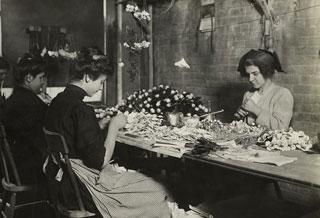
Women making flowers in lower Manhattan, c. 1910
Photo: Lewis Wickes Hine
Collection of New York Public Library
Human-flower workers of the world, unite!
In the U.S., it’s Labor Day, a hard-earned holiday for most in this country. At HFP, we honor the many thousands of flower growers and harvesters, sellers, designers and deliverers, and today pay special tribute to the dexterous tradespeople who make artificial flowers.
This is an old craft that should have been featured, alongside gunpowder and paper-making, at the Beijing games. Most scholars believe the first “permanent botanicals” were made from silk, by the Chinese. In the Middle Ages, the Italians were making their own artificial flowers from cocoons; by the 14th century the French had learned most of their neighbors’ secrets and began improving on their techniques. “In 1775, Marie Antoinette was presented with a silk rosebud, and it was said to be so perfect that it caused her to faint.”
With the Revolution – and both regalia and fainting out of style – fake-flower artisans emigrated to England and the U.S. just in time for the ascent of industrialization and Victorianism: the market for floral-everything exploded and factories of artificial flower-making sprang up to meet demand.
Flower Maker, New York City
c. 1910
Photo: Lewis Wickes Hine
Collection of New York Public Library
In the U.S., most of the artificial flower shops were clustered “south of 14th St and W of Broadway” in Manhattan. So documents Mary Van Kleeck in her superb ethnography, written for the Russell Sage Foundation and published, with photos by Lewis Hine, in 1913.
“In the making of a flower the hand worker has no mechanical rival. No inventor has been able to harness electricity or steam to any instrument which can reproduce the deft twist of the skilled rose maker’s fingers or the discriminating touch of the worker who tastefully groups together leaves and finished flowers.”
Images of young girls, heads bowed in concentration, were fragile, focused, alluring: “The first glimpse of girls at work at this delightful trade fills one with enthusiasm for it,” wrote G. M. Oakeshott in 1903, “especially at the contrast it makes with the unskilled, rough and dirty trades so often pursued by women. The long tables at which the girls sit to work are covered with many coloured fabrics, which their quick fingers twist and pinch into the flowers, which are hung, when finished, on wires running the length of the tables above their heads. The bright materials in their hands, and the rows of flowers above, give a gay and festive appearance to the workrooms.”
Unfortunately, JSTOR ends its online presentation of Oakeshott’s essay here. We feel sure that the grim realities of the craft follow.
Actually, the flower-maker became an especially poignant (i.e. pretty and female) public victim of urban industrialization. See Edith Wharton’s tragic story The Bunner Sisters, the sad tale of Eliza and Evalina who make artificial flowers for New York’s hat trade. Kate Richards O’Hare wrote an angry (and maudlin) story of Roselie Randazzo, an Italian immigrant, for the socialist Appeal to Reason, 1904.

Inside a Manhattan flower factory, c. 1910
Photo: Lewis Wickes Hine
Collection of New York Public Library
“I forgot Roselie until a shrill scream from the little Jewess across the table reached me and I turned in time to see Roselie fall forward among the flowers. As I lifted her up the hot blood spurted from her lips, staining my hands and spattering the flowers as it fell. The blood-soaked roses were gathered up, the forelady grumbling because many were ruined, and soon the hum of industry went on as before. But I noticed that one of the great red roses had a splotch of red in its golden heart, a tiny drop of Rosie’s heart’s blood and the picture of the rose was burned in my brain.” Rosalie Randazzo died of a brain hemorrhage at age 17.
Melodrama and diatribe weren’t the only modes of socialist writing at the time. Van Kleeck’s report takes a bleached, social scientific approach, with data from the 1900 census (72% of the flower makers were between 16 and 25 years old; most workers earned between $5 and $6 per week) and anthropological interviews with the young women in the flower factories.
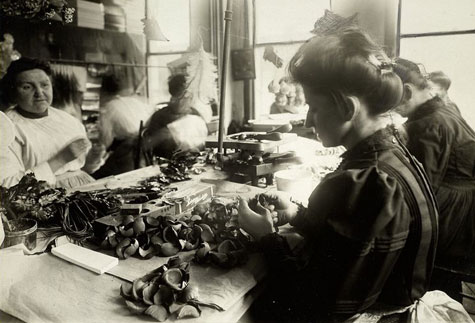
Making rose petals, New York City, c. 1910
Photo: Lewis Wickes Hine
Collection of New York Public Library
““I don’t like the trade,” said one girl. “ I happened to learn it because one day I saw a sign on a door and I went upstairs to a shop. I got into it and I don’t seem to be able to get out of it.’”
This being Labor Day, we were particularly interested in Van Kleeck’s information about efforts, very unsuccessful, to unionize the silk rose and crepe tulip makers early in the 20th century. Here are several excerpts that describe those failed efforts and the different attitudes that workers of various backgrounds held toward the prospect of a union:
“The Flower Makers’ Union was organized about 1907, but broke up in six months or so. There were about 200 members including girls and men cutters, colorers, etc. They met every Friday evening in a hall on 2nd Street near Avenue A. The dues were 5 cents a week. The girl interviewed said it was hard to persuade girls to join. They were not interested. One girl said, “I’m going to get married soon,” and another, “I got a fellow. Vy should I join?” When asked the aims of the union again, the girl informant said, “We started to kick about wages.. But when I asked my boss for a raise, he said, “For vy should I gif you a raise? Didn’t I teach you the trade?” However this girl is not interested in starting the union again, as she has a fairly good position with steady work all year, and does not now feel a personal need for its support.
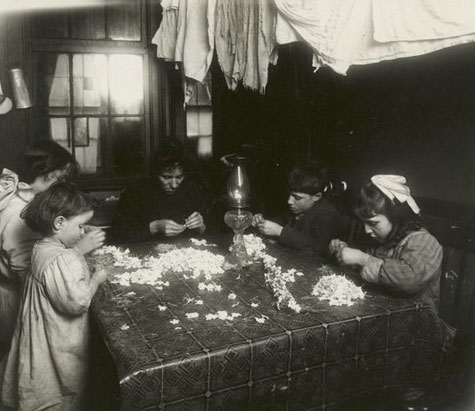
The whole family works at a cottage flower industry
Photo: Lewis Wickes Hine
“The second girl said that the union was started chiefly by girls in the Broadway flower factory in which she happened to be employed. She was the secretary. Most of the members were Jewish girls, who had just come from Europe and could not speak English, and the discussions were carried on and the minutes kept in Yiddish. They met in a hall on 2nd Street. They had several mass meetings but there were very poorly attended, with one exception, when several fore-women came and there were English and Italian speakers.
“In 1909 or 1910 an attempt was made to unite the milliners, wire makers, and flower makers into one union so that they could control the trade, but it was not successful. Since then the Flower Makers’ Union has been replaced by the Educational League of Flower Makers, which meets every Saturday evening. Yiddish only is spoken at its meetings….”
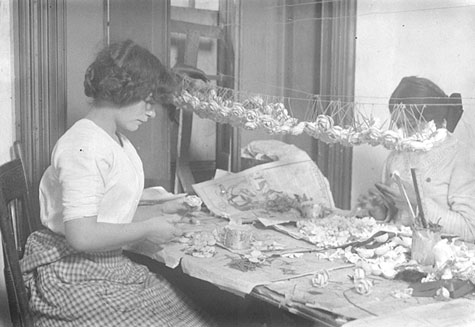
At-home flower-factory, c. 1910, New York City
Photo: Lewis Wickes Hine
“Many girls ‘especially the Americans’ are not interested in joining, “because they don’t expect to stay in the trade. They think only of themselves,’ said this girl. “Perhaps some day they will have daughters working at this same trade, and they could help them if they would form a union.”
Perhaps. But nearly a hundred years later, the daughters, granddaughters, and great-granddaughters of those women are not likely making flowers. For this handcraft industry, like many others, has vanished from the U.S. By the mid-20th century, except for the priciest “permanent botanicals”—still made in France—most silk flowers were being pinched and twisted in Hong Kong. In fact, artificial flower makers and their labor movement hold an important place in Hong Kong’s modern history.
In the spring of 1967, some 300 workers were fired from the Flower Works factory in San Po Kong, an industrial precinct of Hong Kong.
“On May 6, 1967, 21 people were arrested when a group of the sacked workers tried to prevent goods leaving the factory. Leftist unions staged protests over the arrests and demanded the release of the arrested workers. The left wing was inspired by Beijing authorities’ public support for the ‘anti-British struggle,’ particularly an editorial in the People’s Daily on June 3, 1967, which called on the Hong Kong Chinese to ‘be ready to respond to the call of the motherland to smash the reactionary rule of the British.’”
The events surrounding the Flower Works firings and demonstrations that followed are still vivid—the subjects of debate. Were the workers made martyrs by pro-Communist forces on the mainland? Or was this the natural outpouring of local resistance to British rule? Riots continued through the end of the year; 1,936 people were convicted of crimes and more than 50 people died.
“Even to this day, a ‘siege mentality’ still exists among some leaders of the traditional leftist camp a decade after the handover. The 1967 disturbances – a spillover from the Cultural Revolution which Chairman Mao Zedong had begun on the mainland a year earlier – was the most controversial event in the history of Hong Kong.”
And what about the flower makers? Have conditions changed much for them across the world since Mary Van Kleeck compiled her report for the Russell Sage Foundation and Kate Richards O’Hare memorialized young Roselie Randazzo? Since the Flower Workers in Hong Kong barred shipment from the factory?
We wish we could say.
This company in Thailand promotes that its flower makers belong to “a women’s workers co-operative within a village in central Thailand.” Though the company is based Hull, U.K., the flower makers are in rural Thailand.
“They are a registered OTOP company which is an initiative by the Thai government to retain craft skills and provide additional work/income to rural communities. This endevours to reduce mass migration to urban areas, retain craft skills for future generations and improve living conditions within rural communities through improved education and introduction of modern technology.”
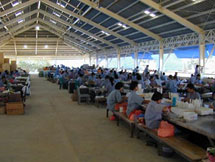 A flower factory in rural Thailand
A flower factory in rural Thailand
Photo: Permaflora
This Thai company also has a rural factory (an open-air equivalent of what Lewis Hine photographed in New York a century ago). In 2003, J.S.Flower “started the Labor Standard Development program in co-operation with 4 government offices aiming to improve the workers educations, skill, safety, working environment and the factory productivity.“
It’s hard to tell whether this educational effort is designed only to perfect and speed production of latex-coated orchids or to provide the Thai equivalent of GED certificates. Perhaps it’s doing both.
We welcome further information about flower-makers across the world, their wares, their customs, their wages, and their working conditions.
Comments
Ah, I guess I do need to grow my own flowers for cutting.
I second Dee. This was a fascinating essay. I enjoyed the combination of history and present and the photographs illustrate the trade really well.
For those of us who were kids when Bobby Darren sang the song, those words “Artificial Flowers” have always had a sad undertone – thanks for your thoughtful Labor Day essay, Julie.
I found the song on YouTube if anyone is interested.
http://www.youtube.com/watch?v=-GMjRj29SI0
After Sheldon Harnick & Jerry Bock wrote “Artificial Flowers” they wrote the score for Fiddler on the Roof.
Annie at the Transplantable Rose


Julie, that was simply fascinating. What a sad story about a sad trade. I’ll never look at fabric flowers the same way again.~~Dee